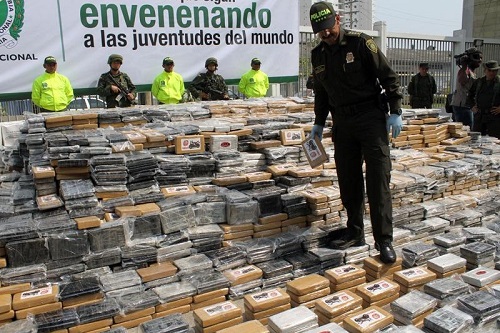AP photo
By
Ricardo Swire
Earlier in January 2018 a specially combined Spanish/Portuguese law enforcement counter-narcotics team, targeting complex transnational drug trafficking organizations, simultaneously intercepted seven hundred and forty-five kilos of cocaine in Spain and Portugal during an operation. The sophisticated criminal network routinely imported Colombian cocaine in shipping containers. On this occasion the nine member syndicate, including three Colombians and one Venezuelan, attempted to smuggle three hundred and fifty-five kilos of cocaine inside pineapples.
Two Colombian brothers led the transnational criminal outfit. The siblings coordinated logistics such as transportation and warehousing, when cocaine consignments arrived in Barcelona, Spain. After transiting a stash house the South American cocaine shipments were dispatched to “laboratories” in Pinto and Nuevo Baztan cities in Madrid. The multi-agency law enforcement team also seized US$490,000 or €400,000, two hydraulic presses, precision scales, three packaging machines and official documentation from fruit import companies. In 2014 two point five metric tons of cocaine filled pineapples were confiscated in Spain, aboard a Costa Rican ship.
Caribbean intelligence data highlighted the reverse smuggling route, on which another team of international counter-narcotics operatives seized one point four five metric tons of cocaine. The shipment was camouflaged in a container of frozen fish, dispatched from Belgium’s port of Guayaquil. The Colombian cocaine packages “trademarked” with multiple images representing the Russian President, a Chainsaw and a Bull. Ecuadorean law enforcers detained and charged the local customs agent handling the shipment’s documentation.
Drug trafficking trends outlined Portugal as both a prized cocaine transit point and market. Product is usually destined for Belgium, Holland and Spain. Colombian cocaine shipments to Spain travel via Cape Verde and is usually intercepted in Algarve’s coastal waters. Algarve is Portugal’s most southern area. 2012 statistics showed worldwide cocaine seizures increased to six hundred and seventy-one metric tons annually. South America, Western and Central Europe recorded the highest.
The January 2018 interception demonstrates how Colombian drug titans’ Spanish operations have revolutionized trafficking in Europe. Law enforcers secured one thousand six hundred and forty-two pounds of cocaine and close down one lab. Originally, Colombian “narcos” imported cocaine for the “Ndrangheta” and other European organized crime syndicates to distribute. The Iberian Peninsula utilized as favorite entry-point to Europe.
Today Colombian networks “breakdown” and distribute their own cocaine consignments in Madrid and other major European cities. Reports confirm Colombia’s “Rastrojos” or “Urabenos” cartel commands a heavily armed presence in Europe. “Oficinas de Cobro” or Debt Collection bureaus in Spain are connected to several kidnappings and murders. Transnational drug lords take advantage of Europe’s reality that Colombians no longer need a visa to enter the “Schengen Area.” The formal zone is made up of twenty-six European states that abolished passport and border security programs at mutual borders.
Ricardo Swire
Ricardo Swire is the Principal Consultant at R-L-H Security Consultants & Business Support Services and writes on a number of important issues.



No Comments Yet!
You can be first to comment this post!